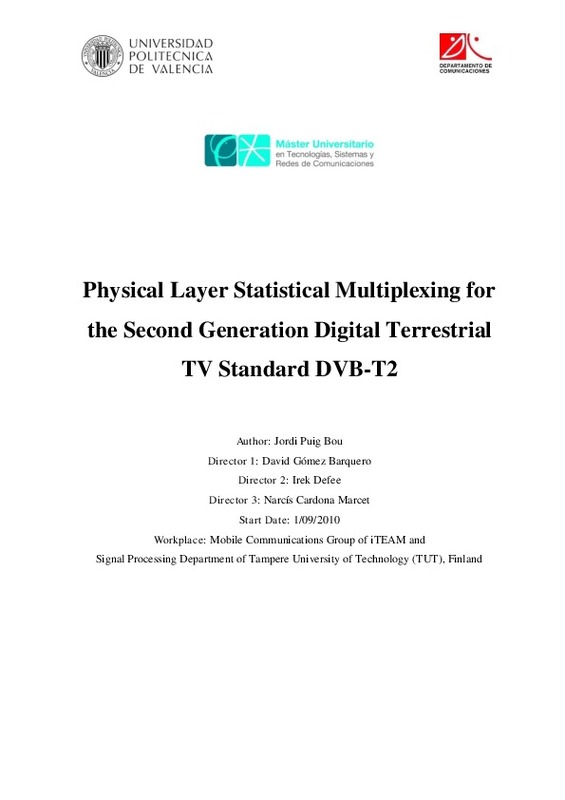JavaScript is disabled for your browser. Some features of this site may not work without it.
Buscar en RiuNet
Listar
Mi cuenta
Estadísticas
Ayuda RiuNet
Admin. UPV
Physical Layer Statistical Multiplexing for the Second Generation Digital Terrestrial TV Standard DVB-T2
Mostrar el registro sencillo del ítem
Ficheros en el ítem
| dc.contributor.advisor | Gómez Barquero, David
|
es_ES |
| dc.contributor.advisor | Defee, Irek
|
es_ES |
| dc.contributor.advisor | Cardona Marcet, Narciso
|
es_ES |
| dc.contributor.author | Puig Bou, Jordi
|
es_ES |
| dc.date.accessioned | 2013-02-22T11:06:40Z | |
| dc.date.available | 2013-02-22T11:06:40Z | |
| dc.date.created | 2011 | |
| dc.date.issued | 2013-02-22 | |
| dc.identifier.uri | http://hdl.handle.net/10251/27249 | |
| dc.description.abstract | [ES] En esta Tesina se han desarrollado algoritmos de multiplexación estadistica de servicios en capa física para el estándar de televisión digital terrestre de segunda generación, DVB-T2. Además, se ha hecho un estudio de las mejoras aportadas por este nuevo método de multiplexación con respecto a técnicas previas. | es_ES |
| dc.description.abstract | [EN] DVB-T2 (Digital Video Broadcast ¿ Second Generation Terrestrial) is the new specification for the second generation of digital television. Currently, this standard is commercially deployed in UK, Sweden, Italy and Finland. Within the new features of this specification it should be noted the capacity improvement (close to 50%) with respect to DVB-T. On the other hand, the main changes are found in the physical layer where DVB-T2 incorporates a new concept, the Physical Payer Pipe (PLP). Each PLP contains an individual configuration of modulation, coding and interleaving. This new concept allows a transmission with multiple PLPs (MPLPs) where each service can be transmitted with different physical layer configuration. To perform this MPLPs configuration a physical layer service allocation is needed. By this way, in DVB-T2 the service allocation should be efficiently improved at the physical layer, not in the upper layers like in the first generation of DVB standards. This thesis work aims to study the statistical multiplexing methods in the upper layers to design a new algorithm in the physical layer. This algorithm seeks to enhance the bandwidth utilization, reduce the service buffering delay and increase the number of services in the transmission. In order to achieve the objective a simulation platform has been developed to analyze different multiplexing methods with a real DVB-T2 network configuration, verifying the potential gain of the new proposal. | es_ES |
| dc.format.extent | 35 | es_ES |
| dc.language | Inglés | es_ES |
| dc.publisher | Universitat Politècnica de València | es_ES |
| dc.rights | Reconocimiento - No comercial - Sin obra derivada (by-nc-nd) | es_ES |
| dc.subject | Dvb-t2 | es_ES |
| dc.subject | Multiplexación estadística | es_ES |
| dc.subject | Algoritmos de capa física | es_ES |
| dc.subject | Statistical multiplexing | es_ES |
| dc.subject | Physical layer algorithms | es_ES |
| dc.subject.classification | TEORIA DE LA SEÑAL Y COMUNICACIONES | es_ES |
| dc.subject.other | Máster Universitario en Tecnologías, Sistemas y Redes de Comunicaciones-Màster Universitari en Tecnologies, Sistemes i Xarxes de Comunicacions | es_ES |
| dc.title | Physical Layer Statistical Multiplexing for the Second Generation Digital Terrestrial TV Standard DVB-T2 | es_ES |
| dc.type | Tesis de máster | es_ES |
| dc.rights.accessRights | Abierto | es_ES |
| dc.contributor.affiliation | Universitat Politècnica de València. Escuela Técnica Superior de Ingenieros de Telecomunicación - Escola Tècnica Superior d'Enginyers de Telecomunicació | es_ES |
| dc.description.bibliographicCitation | Puig Bou, J. (2011). Physical Layer Statistical Multiplexing for the Second Generation Digital Terrestrial TV Standard DVB-T2. http://hdl.handle.net/10251/27249. | es_ES |
| dc.description.accrualMethod | Archivo delegado | es_ES |
Este ítem aparece en la(s) siguiente(s) colección(ones)
-
ETSIT - Trabajos académicos [2408]
Escuela Técnica Superior de Ingenieros de Telecomunicación






